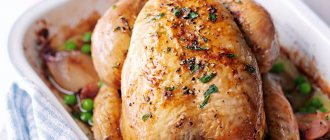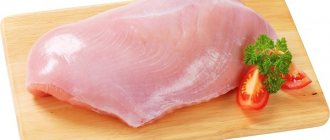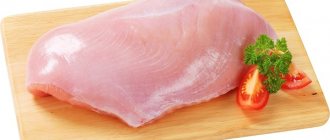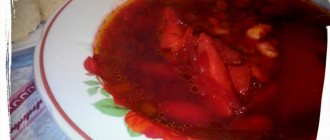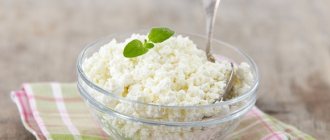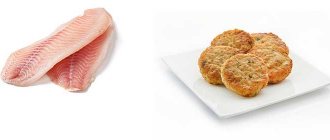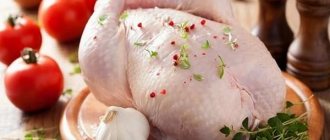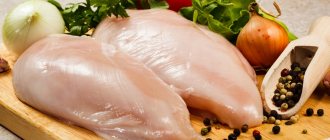Properties of meat
The breast portion of the chicken is high in protein and low in fat and carbohydrates. Proteins are the building blocks of cells. They, unlike sugars, are digested slowly, and the body remains full for a long time. At the same time, the calorie content of poultry is quite low, which makes it indispensable for diets.
Fillet is accessible to the middle class due to its low price. The prevalence of chicken plays into the hands of producers. In an effort to raise a large population in a short period of time, factories inject birds with growth stimulants, which does not have the best effect on health.
It is chicken that is most often subjected to hormone therapy. Men are not advised to abuse this type of meat: they may develop feminine traits.
Energy value of chicken meat
The calorie content of fillet is 113 kcal.
The energy value of an individual piece may vary: it varies depending on the processing method. The number of calories in meat on the bone is higher than in fillet, and can reach up to 137 kcal.
Chicken breast with skin has a calorie content of 164 kcal per 100 grams.
Boiled chicken breast has a calorie content of 95 kcal per 100 grams, smoked - 119 kcal, when fried, the energy value of chicken reaches 197 kcal.
And a little about secrets.
The story of one of our readers, Inga Eremina:
I was especially depressed by my weight; at 41, I weighed as much as 3 sumo wrestlers combined, namely 92 kg. How to completely lose excess weight? How to cope with hormonal changes and obesity? But nothing disfigures or makes a person look younger than his figure.
But what can you do to lose weight? Laser liposuction surgery? I found out - no less than 5 thousand dollars. Hardware procedures - LPG massage, cavitation, RF lifting, myostimulation? A little more affordable - the course costs from 80 thousand rubles with a nutritionist consultant. You can, of course, try to run on a treadmill until you go crazy.
And when will you find time for all this? And it's still very expensive. Especially now. Therefore, I chose a different method for myself.
Chicken breast is a popular dietary product because it has very low calorie content and an optimal ratio of proteins, fats and carbohydrates. However, the method of preparing meat is of no small importance, since when using different methods, the number of calories in this dish and its qualitative composition can vary significantly. To follow the principles of a healthy diet, you need to know what kind of cooking of chicken breast is optimal to preserve healthy protein and low calorie content.
Raw chicken contains about 23.5 g of protein (B) per 100 grams of product. This figure is directly dependent on the quality of the raw materials. Cheaper birds are injected at factories with special compounds that increase the weight of the product due to the injected liquid. In this case, the B content per unit of unprocessed white meat is reduced.
However, meat is rarely eaten raw, so it is much more important to know the amount of B in the finished brisket. It differs slightly depending on the cooking method. The approximate content of B in chicken breast per 100 g is presented in the table:
| Method of cooking chicken | Content B per 100 g of finished product |
| Boiled | 27,5 |
| Smoked | 24,5 |
| Steamed | 23,5 |
| Fried | 25,0 |
| Baked | 26,0 |
The benefits of poultry meat
Protein is the building material of muscles. The composition of chicken includes all essential amino acids. Proteins are easily digested, which benefits the immune system.
Chicken fibers absorb acids, so the meat can be prescribed to those suffering from high acidity, ulcers and gastritis.
Sulfur is part of some amino acids.
Chicken contains a lot of phosphorus (only fish has more) - an invaluable element for bones, teeth, DNA and RNA molecules.
Chlorine is the main extracellular ion. Together with potassium, it participates in conducting electrical impulses and regulates fluid pressure in cells. The element is useful for the stomach because it contains hydrochloric acid HCl, without which food digestion is impossible.
Fluoride serves as a component of bones and teeth, promotes wound healing and iron absorption.
Cobalt is an essential component of vitamin B12.
Zinc is necessary for the functioning of the pancreas and sperm production.
Choline, from which acetylcholine is synthesized, is the most important inhibitory transmitter (a substance that mediates the transmission of nerve impulses) in the central nervous system. Choline improves memory performance. It produces deoxycholic and ursodeoxycholic acids, which are part of bile.
Detailed composition of fillet
To begin with, it is worth noting that the calorie content of a chicken breast (clean meat without skin and bones) is only 113 kilocalories.
Including 100 grams of regular fillet contains: Nutritional value and chemical composition of chicken breast
| No. | Unnaming a component | Quantity, gram | Quantity, kilocalories | Calorie ratio, % |
| 1 | Squirrels | 23,6 | 94 | 83 |
| 2 | Fats | 1,9 | 17 | 15 |
| 3 | Carbohydrates | 0,4 | 2 | 2 |
| 4 | Water | 74,8 | — | — |
| 5 | Ash | 0,98 | — | — |
But the relatively low calorie content of chicken breast is not its only advantage. Tender fillet contains a huge amount of useful amino acids, as well as vitamins A, C, PP, H, B3, B6 and B12. And elements such as chromium, zinc, magnesium, potassium, sodium, sulfur, choline and cobalt make it a real life battery. Consumption of such meat allows sick people to forget about problems with vision, blood vessels, nervous and circulatory systems. In addition, the miraculous fillet allows you to strengthen your immune system and forget about excess weight for a long time.
In what form is the product best consumed?
Chicken carries salmonella. If the meat of a large carcass near the bones is undercooked, this can cause salmonellosis. The disease causes severe intestinal lesions and vomiting.
It is best to boil, steam or bake the fillet in foil. With the latter method, all the beneficial substances will remain in the meat, and it will be juicy.
Chicken breast (in other words, white chicken meat) is a wonderful product, tasty and healthy.
Boiled chicken breast is truly a dietary product. Boiled white meat is used in preparing all kinds of salads, stews, vegetable soups, pates, and minced meats. Thanks to its composition, boiled chicken breast is suitable for people of any age - both small children and the elderly. Due to the presence of vitamins and other beneficial substances in it, it is well suited for athletes and those on a diet.
How many calories are in boiled skinless chicken breast:
If boiled white chicken meat does not have skin, its calorie content will decrease.
The calorie content of boiled skinless chicken breast is 110 kcal per 100 g. product
How many calories are in baked chicken breast:
There is a simple way to prepare white chicken meat - bake a chicken breast.
Calorie content of baked chicken breast is 137 kcal per 100 g. product
How many calories are in chicken breast baked with cheese:
The taste of white chicken meat can be perfectly combined with the taste of cheese. A wonderful dish - chicken breast baked with cheese - will delight you not only with its taste, but also with its relatively low calorie content.
Calorie content of chicken breast baked with cheese – 119 kcal per 100 g. product
How to cook chicken breast?
Chicken meat can be prepared in the following ways:
- bake in the oven;
- fry;
- cook;
- stew;
- steam it.
Fried fillet is the least healthy and the most high in calories, however, it is the easiest way to prepare it. Some people beat the breast before frying, others do not. Fry the meat for 4 minutes on both sides; season and add salt if desired.
But it will take longer to cook or stew the breast. Boiled chicken is eaten raw extremely rarely; it is mainly used as a component for salads.
What is included in chicken meat>
- B3 (niacin) is involved in metabolic reactions, promotes the production of energy from carbohydrates, fats and proteins, and is part of cellular enzymes involved in respiration and metabolism.
- B4 (choline) is involved in the synthesis of acetylcholine, which transmits nerve impulses, regulates insulin levels, promotes the normal functioning of the liver, kidneys and hematopoietic organs.
- B6 (pyridoxine) is involved in the metabolism of proteins and fats. Contributes to the production of red blood cells that distribute oxygen. Necessary for the conversion of glycogen into glucose, for the normal functioning of the immune system and for the formation of nerve cells.
- B9 (folic acid) is essential for the functioning of the circulatory and immune systems.
White chicken meat contains vitamins A, C, H. Chicken breasts are an excellent source of selenium and phosphorus. They contain potassium, magnesium, sulfur, chromium, copper, fluorine, zinc. True, chicken meat is significantly inferior in iron content to beef and pork (1.5 mg versus 3 mg per 100 g of product).
Compound
Chicken breast has the following digital content of nutritional ingredients and nutrients:
- Proteins – 23 g
- Fats – 0.5 g
- Carbohydrates – 0.4 g
- Calorie content – 110 kcal
- Vitamins – A, C, H, PP, group B
- Minerals – sodium, magnesium, iron, potassium, sulfur, cobalt, copper, selenium and others
Why, when talking about protein, is the emphasis placed on the finished product? Because there is slightly less protein in the raw product - about 23 g per 100 g. During the heat treatment, the amount of water decreases slightly, but the amount of protein remains unchanged, respectively, the percentage in the finished meat increases.
It should also be noted that chicken breast protein is easily digestible.
The benefits of chicken fillet
Chicken breast is not only a valuable source of protein for our body, but also contains many different vitamins and minerals. Vitamins, in turn, take an active part in the processes of protein synthesis and other substances. Vitamins are essential for strength training; without them, it is impossible to effectively lose weight or increase muscle mass, regardless of the amount of protein consumed.
Chicken breast contains vitamins B, C, PP, A, as well as choline, a substance that ensures the proper functioning of organs, in particular the kidneys and adrenal glands, and cleanses the liver of excess fats and cholesterol. Potassium, which is contained in chicken fillet, acts as electrolytes in the body and helps maintain normal blood pressure. Chicken breast also contains equally important micro- and macroelements: sodium, magnesium, sulfur, iron, phosphorus and chlorine.
The nutritional value of chicken breast is great. This is a quite nutritious and healthy product, but the calorie content of chicken breast is balanced. 100 grams of fillet contain the most protein - 23.6 grams, there is little fat - 1.9 grams, and very few carbohydrates - up to 0.4 grams.
Boiled chicken breast is very useful for problems with the gastrointestinal tract, including gastritis and ulcers, it promotes digestion and neutralizes excess acidity in the body. White chicken meat is also useful for problems with blood vessels, it helps prevent heart attacks and strokes, and
The low calorie content of boiled chicken breast helps not to overload the body with extra calories. It is best to boil chicken in a saucepan, but the healthiest option is steamed chicken, which retains all the nutrients, has a beautiful appearance, and becomes very juicy and soft. Chicken breast is best consumed with vegetables to balance the simultaneous intake of protein and fiber in the body.
Chicken fillet is good for teeth, bone tissue and muscles; it contains the largest amount of zinc and phosphorus. Magnesium improves memory, restores nerve cells, relieves irritability, promotes wound healing, and B vitamins normalize blood sugar levels, which is why chicken breast is also recommended for elderly people.
Eating chicken breast has a positive effect on the body's metabolic processes, improves skin color, condition of nails and hair, and the selenium and lysine it contains have good antibacterial properties and strengthen the immune system, preventing colds.
Chicken fillet composition
How many calories are in chicken fillet? This question is asked by many of those who diet or lead a healthy lifestyle. To answer the question - how many calories are in chicken fillet, you need to find out what this product consists of.
Chicken fillet is the most valuable part of a chicken carcass. The calorie content of chicken fillet includes a lot of protein of animal origin and the main part of it is occupied by amino acids, without which the human body cannot function normally.
In addition to protein, the calorie content of chicken fillet includes phosphorus (only seafood can boast of such an element) and other useful substances - vitamins H, vitamins B and PP, chromium, cobalt, magnesium, sulfur (by the way, cobalt is present in one hundred grams of chicken fillet 120 percent, which is the daily human requirement).
Answering the question about how many calories are in chicken fillet, it should be said that the calorie content of chicken fillet is about 163 kcal per hundred grams of product.
Diets with chicken breast
Thanks to its balanced composition, chicken breast is an excellent diet product. So experts in the field of weight loss have developed several types of diets based on chicken breast. The first of them is seven days. For it you need to boil 800 g of chicken meat in 2 liters of water. In order to preserve the taste of the product, you can add celery root, carrots and onions to the pan to taste. Then divide the boiled chicken meat into 5-6 equal portions in proportion to meals per day. The main feature of the diet is the non-use of salt when preparing dishes. It is also prohibited to add soy sauce to enhance the taste. You can use lemon juice to add some piquancy. The disadvantage of this diet is that it cannot be used for people with kidney, liver, heart and stomach diseases. In addition, it is also contraindicated for pregnant women.
There is a second diet option using chicken meat. It is designed for the same 6-7 days. In the first three days, you are allowed to eat only apples (1.5-2 kg per day in equal shares). Then 1 day - 1 kg of chicken breast, the next 2 days - 2 liters of kefir (1%) per day. Last day - chicken broth, prepared without salt.
On average, following one of the diets you can lose from 1.5 to 3 kg, which is not a bad result. Plus, chicken breasts are so nutritious that you won't feel hungry.
Useful properties of boiled breast
Let's start with the fact that the energy value of a cooked product is absolutely no different from a raw one. This means that protein is also preserved in this meat.
The boiled fillet contains the same set of useful vitamins and minerals. For eating boiled fillet, it is very suitable for people of all age categories. It can be given to both young children and elderly people. It is very good in the diet of an athlete and in the menu of those who are on a diet.
Using fillet in this form, you will never go hungry. It goes well with many side dishes, is very popular in many salads and is suitable for making rolls, sandwiches, rolls, sausages, homemade snacks and much more. That is, even while on a very strict diet, with the help of this product you can perfectly diversify your diet without compromising the calorie content of your dishes.
Steamed chicken beneficial properties
It is highly recommended to cook many foods using steam. It is not only tasty, but also undoubtedly healthy. Steamed food is an opportunity to preserve all the beneficial properties of vegetables and meat without losing the taste of the product.
Steaming meat is recommended for athletes, those losing weight, and people suffering from certain diseases; this method is also suitable for those who simply care about their health.
Steaming is quite simple and the whole process does not require any specific skills. Sirloin prepared in this way can be served with various side dishes and vegetables.
How to properly cook chicken breast
Lean white meat should not be overcooked, otherwise it will turn into dry and tasteless rubber. Breasts should be thawed (retail chains offer customers fresh-frozen or chilled meat), freed from skin and excess fat and placed in boiling water. The water should completely cover the chicken meat. To preserve more valuable vitamins and microelements in the meat, cook it over low heat, along with aromatic seasonings:
The chicken is not covered with a lid during cooking. Aromatic roots and spices are added to the water. This can be onions, carrots, parsley and celery (root or stems), leeks, thyme, rosemary, garlic, basil, cloves, peppercorns, bay leaves, etc. Salt is added at the end of cooking.
White chicken meat is used to make dietary broth and low-calorie vegetable soups, rich in vitamins and minerals. The calorie content of broth made from lean white meat chicken is about 20 kilocalories per 100 grams of product:
1. Pour cold water over the chicken breast.
2.Add:
- one large onion;
- 2 carrots;
- celery stalks;
- a few sprigs of fresh parsley or cilantro;
- salt and pepper to taste;
- 6 cardamom grains;
- Bay leaf.
3. Bring to a boil, reduce heat, and simmer for 40 minutes.
4. Remove the breast from the broth. Strain the broth, cool and place in the refrigerator. Then remove the top layer of fat.
5. If desired, the finished broth can be poured into containers and placed in the freezer.
Chicken breast is considered one of the most valuable dietary products.
Chicken breast is considered one of the most valuable dietary products. In terms of the content of useful substances, it is equated to seafood. Athletes especially appreciate it. This is not surprising: it is considered the main source of beneficial biochemical compounds necessary for restoring energy and growing muscle mass.
Why breast fillet is better than whole chicken
Let's start with the fact that this is a complete white meat, which has a very high degree of benefit. It contains the least amount of fat and carbohydrates, if not to say that they are not there at all. This meat does not create discomfort in the digestive tract and is very easy to digest and assimilate.
Another benefit of this cut of chicken is that it doesn't take very long to cook. Also, a kilogram of this product is quite affordable in price and is suitable for a wallet of any thickness.
The finished breast retains all the vitamins and minerals that are essential for the body. For athletes, this product is absolutely irreplaceable, as it is an excellent source of pure protein, which helps make it easier to endure difficult workouts.
Also, this meat is good for drying; it will help not harm your health by combining heavy physical activity with a diet.
To prevent the meat from seeming dry, the main thing is to learn how to cook it correctly. If you are trying to reduce your salt intake, white meat can be served with soy sauce without adding salt when cooking it. If you want to get a juicy breast, simmer it over low heat with vegetables or make steamed cutlets with a large addition of onions, it will give juiciness and improve the taste.
A little history
The first birds that humans tamed were chickens. The exact time when this happened is unknown. According to one version, about eight thousand years ago, our distant ancestors sheltered bush chickens, which lived in the jungles of Southeast Asia, in their households. Chicken meat was used for food, and the down was used for household needs.
Much later, new breeds were developed, varied both in appearance and in economic purpose. Today, chickens are raised in individual households as well as on farms. Chicken meat, especially breast, remains one of the most affordable and at the same time healthy products. It is widespread in many countries of the world and is used both for preparing everyday dishes and in haute cuisine menus. Delicate, delicate taste and unobtrusive aroma allow you to effectively combine white meat with various types of products and sauces.
How does breast differ from other meats?
chicken breast, is considered the most valuable
which differs from the energy value of dark meat. Brisket is the meat that is found on either side of the base of the breastbone. Visually it differs from meat, for example, on legs. The breast is light, almost white. Typically, chicken fillet refers to one half of a breast. It looks very attractive and appetizing - much more aesthetically pleasing than other parts of the carcass. At the same time, the muscles of the sternum are characterized by a denser structure.
The advantage of this product is not only the cost, but also the ease of preparation. Even if you buy meat on the bone, it is extremely easy to separate - just make a couple of cuts. The fillet can be cooked either whole or divided into individual pieces. Properly cooked meat is soft and quite juicy. In addition, after a meal there is no characteristic heaviness in the stomach, as happens after eating pork or other meat. Therefore, for those who strive to eat a healthy, balanced diet, but try to avoid fatty foods, chicken breast is an ideal option. And naturally, it should become an integral part of your diet if you go to the gym or follow a protein diet.
Lose weight on chicken breast
Are you wondering if you can lose weight by eating chicken breast? The calorie content of boiled chicken breast is so minimal that it is this part of the bird that has become the basis of a special protein nutrition system (diet) developed by athletes for athletes.
By adhering to this diet, a person receives so much easily digestible protein that its excess goes into building muscle mass. Such popular nutrition systems as the ballerina diet , Atkins diet and the Dukan diet use low-calorie boiled chicken breast in their menus.
Calorie content of boiled chicken breast
Adherents of dietary nutrition believe that it is better to eat white meat boiled. Moreover, the calorie content of boiled chicken breast
very low, and the cooking method itself does not require the addition of additional ingredients that increase the energy value of the dish.
Calorie content is usually called the amount of energy that is formed during the breakdown of biochemical compounds entering the body with food. It is indicated in kilojoules or kilocalories. The biochemical compounds from which energy is produced are proteins, carbohydrates and fats. Therefore, their content in a particular product is called nutritional value. The daily calorie intake for a person is determined taking into account various factors: age category, gender, climatic conditions, physical activity and others. A person consumes more calories than his body needs, the energy balance is disrupted, which leads to the deposition of a fat layer. Therefore, one of the most effective ways to combat excess weight is to reduce calories.
When you consume one hundred grams of boiled chicken breast, you get 137 kilocalories of energy needed by the body. It is produced by the breakdown of:
- almost thirty grams of protein;
- about two grams of fat;
- half a gram of carbohydrates.
Raw chicken breast has less energy value - calorie content 100 grams
is 113 units. The fact is that during heat treatment the calorie content of white meat can change. Various seasonings that are added during cooking increase the “energy intensity” of the product. The presence of skin is of great importance, as it adds approximately another 50 kilocalories per 100 grams of product.
The nutritional value
The first thing worth noting is the low calorie content of this meat. 100 grams of chicken breast contain 113 kcal , of which only 1.9 grams are fat, 23.6 grams are protein, 0.4 grams are carbohydrates.
The minimum amount of protein a person needs is 50-100 grams (based on 0.8-1 grams per 1 kilogram of weight). Therefore, 200-400 grams of breasts are enough to avoid a deficiency. For athletes who need 2-2.5 g of protein per kilogram of weight, this volume is not enough, but the remaining needs can be covered by other products or sports nutrition.
This is interesting: How and how to quickly remove brilliant green stains
Knowing how much protein is in boiled chicken breast, it’s easier to think through your diet and achieve your goals. Such a product should be part of the diet of people who aim to “get lean,” that is, reduce the amount of fat without harming the muscles.

How does the protein content change depending on the method of cooking meat? Here the trend is as follows:
- when cooked, brisket contains 29.8 grams of protein (per 100 grams);
- during the frying , the volume of the useful element does not decrease and remains approximately at the same level;
- steaming 23.6 grams enters the body ;
- smoking reduces the volume of incoming useful elements to the level of 19.7 g .
Now you know how much protein is in chicken. The only question is why its level in a raw product is lower than in one already prepared by cooking. This is easy to explain - raw meat contains 15-20 percent water, which is lost during the cooking process. Thus, a piece of breast that weighed 100 g before processing turns into 70-80 grams. It is logical that the protein content in chicken becomes higher after cooking.
Composition of white meat
Chicken breast is famous not only for its low calorie content, but also for its rich composition of nutrients - vitamins, minerals, organic compounds. In particular, it contains:
all B vitamins that the body needs for normal metabolism;
- retinol;
- ascorbic acid;
- vitamin PP;
- vitamins E, K, H;
- minerals - phosphorus, sulfur, zinc, chromium, magnesium, cobalt, sulfur, iron, chlorine, sodium;
- choline, which is responsible for normalizing kidney function;
- potassium, which helps stabilize blood pressure;
- amino acids (including essential - about 8 grams - and non-essential - almost 13 grams).
But the amount of cholesterol is extremely small - only 0.07 mg/g.
The benefits of chicken meat
Nutritionists around the world have long loved this product and are happy to recommend including it in any diet. Chicken meat is not just an excellent source of protein, but also a source of other beneficial substances such as:
- all B vitamins
- vitamin A
- vitamin PP
- vitamin C
- choline, which helps the adrenal glands and kidneys work, and also helps rid the liver of excess fats
- potassium, which helps stabilize blood pressure and has an effect on nerve impulses
- magnesium
- chlorine
- iron
- phosphorus
- sulfur
A very low level of fats and carbohydrates, as well as many useful qualities, give chicken meat every right to be a healthy product that helps:
- recover from serious illnesses and surgeries
- boosts immunity
- good for diseases of the digestive tract, including ulcers and stomach cancer
- This meat is good for preventing heart and vascular diseases
Useful properties of chicken breast
Most of the composition of chicken breast is made up of proteins. They provide the body with the bulk of calories - about 84%. The presence of this product in the diet prevents protein starvation, which is especially important for athletes and fans of low-carbohydrate diets. Moreover, the protein contained in white meat is very easily digestible. In terms of its beneficial properties, it is only slightly inferior to egg white. In addition, white chicken meat saturates the body with beneficial vitamins and minerals.
Its use is also recommended for normalizing metabolic processes and preventing diseases of the cardiovascular system, including atherosclerosis, heart attack and stroke. Regular consumption of white chicken meat helps strengthen the musculoskeletal system, normalize the functioning of the nervous system (due to the presence of glutamine), and improve the appearance of hair, nails, teeth and skin.
White meat is a real “healing food” for those who suffer from diseases of the stomach and intestines (gastritis, ulcers). This is due to the ability of meat fibers to eliminate high acidity. It is also prescribed in therapeutic diets for diseases such as diabetes, gout, and polyarthritis. This product is also considered one of the most effective means for boosting immunity. Do you need to quickly regain strength after physical activity? Chicken breast will help again. In addition, this product is considered hypoallergenic.
Of course, white meat from young chickens is considered the most healthy - it is more saturated with vitamins and minerals. And naturally, it has the best taste.
What are the benefits of chicken breast?
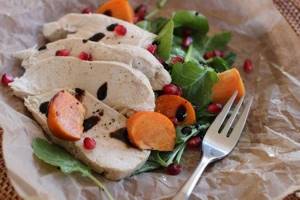
Chicken noodles, stewed breast, fried meat... Chicken in almost any form is good for our health! There are many benefits from eating chicken meat. The fact that it is low in fat and calories but high in protein makes this product ideal for weight maintenance. Not to mention, chicken is literally packed with nutrients and vitamins. Plus, there are plenty of delicious ways to prepare this protein powerhouse.
Here are seven reasons why chicken breast should be in your diet:
- If you're looking for a meat source that's high in protein and low in fat, chicken breast is the way to go. Chicken protein promotes muscle growth and development, helps maintain healthy weight and lose excess weight.
- Chicken contains high amounts of a proteinogenic amino acid called tryptophan, which improves our mood after eating a big bowl of mom's noodles. In fact, if you're feeling down, chicken breast will help increase your serotonin levels, which will lift your mood and calm you down.
- In addition to protein, chicken contains several minerals, including calcium, phosphorus and selenium, which help maintain healthy bones and joints.
- Chicken breast will support heart health. Vitamin B6 plays an important role in preventing heart attack, and chicken contains it in sufficient quantities. In addition, chicken is rich in niacin, which lowers cholesterol, and omega-3 fatty acids, which are beneficial for the cardiovascular system.
- Reduces PMS symptoms. Magnesium found in chicken breast is a nutrient mineral that can help calm premenstrual symptoms and manage mood swings.
- Alpha and beta carotene, lycopene, vitamin A, and retinol are all found in chicken and contribute to eye health.
- Increases immunity. Chicken broth has long been used as a home remedy to relieve cold symptoms. The hot steam of the broth will help get rid of a runny nose and sore throat.
Methods for preparing chicken breast
It has been established that the calorie content of boiled chicken breast
and the calorie content of the same product, but prepared in other ways, differs. In particular, one hundred grams of smoked white meat contains 117 kilocalories. Smoked breast is also very tasty and healthy. Meat processed in this way becomes very juicy, tender and aromatic. However, its beneficial properties are fully manifested if it is processed using technology without the addition of “liquid smoke,” dyes, flavors, or flavor enhancers. The only component that is allowed to be added during this cooking process is salt.
Baking chicken breast is also popular among chefs, which not only gives it a great taste, but also preserves all the nutrients. The optimal option for dietary nutrition is considered to be breast meat in foil, cooked without adding any seasonings.
Stewed chicken breast is also a low-calorie dish, provided that no third-party fats are added during the cooking process. White meat should be stewed in a small amount of water with a minimum of seasonings. Vegetables are allowed. The result is a dish with a calorie content of approximately 93 kcal. But it should be noted that some recipes call for keeping the meat in the marinade before stewing. In this case, you need to carefully consider the composition of the brine - its components can increase the calorie content of the finished product.
Another option is to grill the chicken breast. The meat is fried on both sides (five minutes on each) at minimum temperature. You can also fry it in a frying pan, but without oil, in order to achieve a minimum calorie content.
But the optimal way to cook chicken breast is still considered to be boiling it in water or steaming it. It should be noted that white meat cooks quite quickly. If you expose it to prolonged heat, it becomes hard and the taste characteristics deteriorate significantly. Here are the optimal times for cooking in different ways:
- in a saucepan on the stove - half an hour;
- in a double boiler - an hour;
- in a slow cooker - 40 minutes;
- in the microwave - 10-15 minutes.
To make the meat juicy, it is better to cook the whole breast or fillet. But if your goal is to cook quickly, you can divide it into several pieces.
It is recommended to serve meat with vegetables so that fiber enters the body along with proteins, which helps eliminate connective fibers and other “extra” elements. Athletes are also recommended to eat boiled white meat for breakfast with a side dish of buckwheat or rice.
Protein content per 100 grams of chicken breast
The benefits of breast meat for the body are invaluable when it comes to its protein content. 100 g of unprocessed white meat contains more than 23 g of organic matter. Only seafood contains more building blocks for muscle tissue. Read about the calorie content of chicken breast in our publication.
Due to its low energy value, breast meat cannot be used as the only source of strength; you need to supplement your diet with fruits, vegetables and grains. However, the product is ideal in the period after illness or physical exhaustion.
The amino acid composition is represented by replaceable and essential amino acids (12 and 8 g each, respectively).
During heat treatment, the amount of protein increases: when boiling and frying, by 6 units. When smoking, on the contrary, it decreases by 4 units. Thus, due to weight loss, when cooked in water or oil, the protein in the product becomes greater than when cooked raw. When steaming chicken, the number practically does not change.
How to choose chicken breast?
On store shelves you can find chicken breast in various versions - on the bone and without it, with and without skin, chilled and frozen. To prepare broth, of course, it is better to purchase meat with bones and skin - a liquid dish will be richer and tastier. For boiling with a side dish, baking or stewing, you should choose fillet. In any case, carefully inspect the product. The fillet should be dense, elastic, without damage (punctures, cuts, etc.), bloody streaks, mucus, or bruises. Fresh meat has a dry, light pink surface.
Experts advise giving preference to a chilled product rather than a frozen one - exposure to low temperatures leads to the loss of a significant proportion of nutrients. Chilled fillets are stored at a temperature of 0…+2ºC in special refrigerated display cases. When the norm is exceeded even by 2ºC, bacteria develop in it, including dangerous salmonella.
After cutting the carcass, the fillet must be sold within five days. If the manufacturer specifies a longer period, the meat is not processed without preservatives. When buying breast by weight, you can press it with your finger. If the mark remains for some time, it means the meat was frozen. A pale appearance and flabby appearance may also indicate that the product has been frozen.
To protect yourself as much as possible when buying meat in bulk, it is better to ask the seller for permission to sell this product, which specifies the terms of sale. This way you can check both the integrity of the seller and the freshness of the product.
If the breast is sold in original packaging, it should also be carefully examined. The label indicates information about the manufacturer, period and storage conditions of the meat, but there should be no contamination, much less damage. Pay attention to its tightness and the absence of liquid inside.
You should buy medium-sized breast or fillet (up to 0.5 kg), with neat edges. It is better to avoid too large pieces: many producers, in order to achieve better growth of poultry, introduce hormonal supplements, antibiotics and other stimulants into the diet. There is also this pattern: the larger the breast, the older the chicken was. And the meat of an old bird is always tough, dry and less tasty.
Following these rules when purchasing white meat will help you choose a truly high-quality product that will not only delight you with great taste, but will also benefit the body.
Chicken breast is known to everyone as a tasty and dietary product. Chicken breast is an integral part of the diet of any athlete, person leading a healthy lifestyle or simply watching their weight. Various diets contain dishes that contain breast. The dietary properties of breast are determined by how many calories are contained in chicken breast
. It is worth noting that the price of this product compares favorably with, for example, the same meat. That is, in addition to being useful, it is also kind to your budget. Not to mention the fact that in skillful hands this product can turn into a wide variety of dishes, for every taste and whim.
Oatmeal is very popular among people who want to lose weight among adherents of a healthy lifestyle and is recommended in children's dietary nutrition. Children's nutritionists allow the inclusion of oatmeal in the diet as early as six months of age. Every parent has a preference for one or the other...
What is its calorie content in numerical representation, or in simple terms,
how many calories are in 100 grams of chicken breast
? This figure is 112 Kcal. Including the breast contains:
- Proteins - 23g.
- Fats - 2g.
- Carbohydrates - 0.3g.
These figures may vary slightly depending on the breed of bird, its weight, age, living conditions, nutrition, etc.
A small handful of seeds contains the power of minerals and vitamins. In addition to the nutritional value, the undoubted advantage of these “babies” is the fact that they can be easily included in your daily diet. Here are four types of seeds that you can chew every day. What are the benefits of flax seed for...
How much protein is in chicken breast?

Chicken meat has long been considered as a priority food in a healthy menu. This is confirmed from different points of view. First, it is a recognized fact that chicken meat compares favorably with other varieties in terms of fat content. A 100 gram serving of chicken breast contains only about 3 grams of fat, which is comparable to a teaspoon of butter. The same applies to cholesterol levels, and this is the health of our heart.
Secondly, every time you enjoy chicken breast, you replenish your nutritional reserves. In addition to complete protein, the body is saturated with vitamins and minerals, which contribute to the normal functioning of metabolism and overall health.
How much protein is in 100 g of chicken breast? We should consume protein daily, even more often: at every meal. This is of great importance for our health. It is chicken breast, being an ally of a proper diet, that leaves a special place for proteins. How many grams of protein are in a chicken breast depends on whether it is a cleaned fillet or meat with skin and bones.
On average, the amount of protein in 100 grams of product ranges from 20 to 25 g. The skin, of course, increases the protein content, but it does not add health, since it is replete with not entirely useful substances. For example, antibiotics are included in feed mixtures at poultry farms, and their highest concentration is found in the skin of chickens. And fried chicken skin is a source of carcinogens.
In general, a 100-gram serving of chicken breast will provide almost 25 grams of protein. Imagine, this is ¼ of the weight of the entire portion!
How much protein is in boiled chicken breast? So, 100 grams of boiled skinless chicken breast is an excellent source of protein in meat and can satisfy our daily requirement for it. Moreover, in such a serving of chicken meat, 25 grams represent animal protein, and it contains all the essential amino acids that we need on a daily basis. Thus, the protein in boiled chicken breast is considered high quality and complete.
According to research, the daily protein intake for men is at least 56 g, for women - 46 g. If you lead an active lifestyle with sufficient physical activity, then you will need an additional 1.2-1.4 g per kilogram of body weight daily . Thus, a 100 gram serving of boiled chicken breast is almost half of the daily protein intake for the average resident of our country.
How many calories are in boiled chicken breast?
Tony Primerano
Before cooking, the breasts need to be washed. Then place in a saucepan and fill it with water so that the water completely covers the breasts. During the cooking process, do not forget to remove the foam. After the water boils, salt it, throw in the peppercorns and bay leaf. Reduce heat and cook. Regarding exactly how long to cook the breast, I have a simple rule: if you have boneless fillet, then cook for 20 minutes, if on the bone, then for half an hour. Now the main question is how many calories are in boiled chicken breast?
? If the breast is with skin, then it contains 170 kilocalories, if without, then 110 kcal. As you can see, there is a difference; if this figure is significant for you, then it is better not to eat the skin.
Proper nutrition for a pregnant woman is a good basis for the full development of the fetus. A competent selection of products and a balanced diet will not only have a beneficial effect on the baby’s health, but will also save the expectant mother from problems with her figure in the future. Pregnancy is a happy and...
Benefit
Experts agree that animal protein is the most beneficial for the body. It comes along with carbohydrates and fats, forming the basis of an athlete’s proper diet. It has already been proven that such protein guarantees the correct flow of metabolic processes and accelerates muscle growth.
The available amount of protein in chicken breast at least partially covers the body's needs for building material. At the same time, the product is not used as a source of energy, because it has a low energy value. In addition to protein, it also contains other elements, but in low quantities. How many carbs are in chicken breast? The boiled product contains only 0.5 g of carbohydrates and 1.8 g of fat , which is not enough to cover the energy deficit. But this is not necessary, because boiled chicken is a dietary product, considered a source of building material, not energy.
This is interesting: Can children have diarrhea when teething?
In addition to the main “trinity”, this meat also contains a number of other key elements:
- vitamins - retinol, thiamine, choline, pyridoxine, folic and ascorbic acid, biotin and others;
- minerals - calcium, phosphorus, chlorine, sulfur, sodium, potassium and magnesium;
- trace elements - zinc, fluorine, iron, cobalt, manganese, iodine and many others.

How many calories are in chicken breast broth?
Who among us has not tried chicken broth? This mouth-watering dish will please any gourmet on a hot summer day or a cool autumn evening. The calorie content of the broth can vary significantly, depending on what part of the bird we use to prepare it. Here we will look at the lowest calorie option, namely chicken breast broth. Provided that the volumes of meat and water are approximately equal, the calorie content of broth with breast will be about 130 kilocalories. In the previous chapter, we found out that boiled breast contains 110 Kcal. Accordingly, the broth itself without meat will contain only about 20 Kcal. The figure is impressive.
Take the time to drain the first broth water. At this stage, the broth absorbs harmful substances and a significant part of the fat.
Fats in Chicken Breast
White chicken meat is the basis of most diets, due to the low fat content of the product. The largest amount of it is in the skin, so if the breast is without it, then the dish becomes completely safe for the figure. Replenishment of the daily requirement for the fat element is only 3% per person under 50 years of age with moderate activity.
Fat content in uncooked chicken breast = 1.9 g, same amount in cooked meat.
When frying and baking with oil, the indicator increases. In the first case - up to 7 g, in the second - up to 5.5 g. Athletes choose chicken for daily nutrition, since other types of meat (pork, lamb), with a similar protein content, include much more fat.
How many calories are in fried chicken breast?
Elsie Hui
It is generally accepted that fried foods are harmful a priori. I will give you a simple recipe with minimal use of oil and a delicious result in the end. We will need:
- Breast 400 grams
- Olive oil 1 tbsp.
- Red sweet peppers (paprika) 1.tsp.
- Ground nutmeg 0.25 tsp.
- Oregano 0.25 tsp.
Omega fats have become popular primarily due to the fashion for Mediterranean cuisine. Now it turns out that they can be harmful, and the rules for their use in the diet are constantly evolving... Really? If omega-3 and omega-6 belong to the unsaturated fatty acids (UFAs) necessary for the body...
Prepare the marinade by mixing all the ingredients. Nutmeg has a distinct taste that not everyone likes. If you are one of them, remove it from the recipe. Coat the chicken with marinade so that it evenly covers the entire surface. Since the marinade already contains oil, we will no longer add it when frying. To do this, the frying pan must have a good non-stick coating. Place the pieces in a well-heated frying pan. Fry on both sides, reduce heat and cover with a lid and leave for 10 minutes. The calorie content of such a fried breast will be approximately 190 kilocalories.
How many calories are in baked chicken breast?
To prevent baked chicken breast from being dry, it is best to bake it in a special sauce. For the sauce we need: 1 tbsp. olive oil, 1 tbsp. soy sauce, your favorite seasonings and the secret ingredient - mustard. Mustard will make the breast much juicier. Mix the ingredients for the sauce and coat the chicken breast with it. Let it marinate for 10-15 minutes. Place the marinated breast in foil and place in the oven for 10 - 15 minutes. This baked chicken breast contains 150 kilocalories
.
To summarize, we can say that the most dietary option for preparing chicken breast is boiling or preparing broth. In these cases, the breast will contain the fewest calories.
Chicken breast composition
For those who came only for the numbers, let us immediately note that the calorie content of boiled chicken breast per 100 grams is 137 kcal . For those who want to learn how to use these numbers correctly, let’s continue...
Boiled chicken breast contains the following beneficial substances:
- choline;
- very important B vitamins, namely B12, B9, necessary during pregnancy and lactation;
- vitamins PP, H, C, A, which are able to regulate the activity of the adrenal glands, have a beneficial effect on digestive processes, stimulate hematopoiesis, and cleanse the liver.
Also, before considering the calorie content of boiled breast, let's look at the beneficial microelements that make up it.
And this:
- sodium
- phosphorus
- cobalt
- sulfur
- chlorine
- iron
- manganese
- copper
- selenium
- zinc
- magnesium
- potassium
This entire list of minerals ensures normal functioning of the heart muscle. Helps strengthen the body's immune shield, accelerating the rehabilitation process after surgery and past illnesses. This is why chicken breast broth is considered the only food for the sick both at home and in hospitals.

